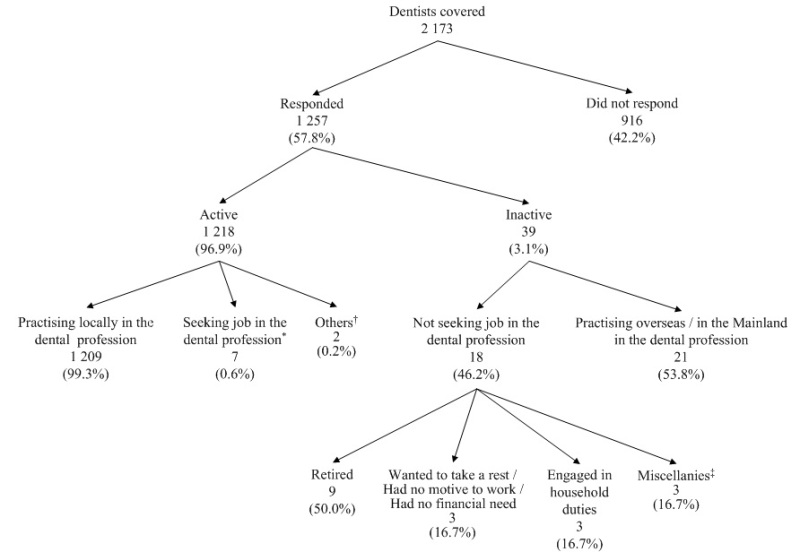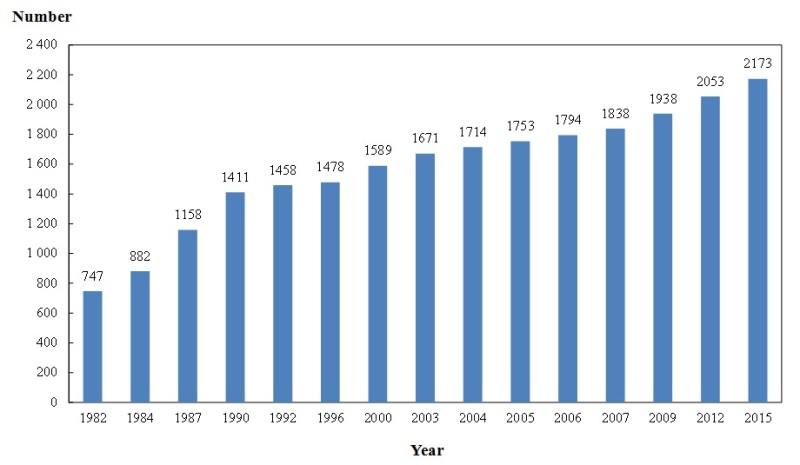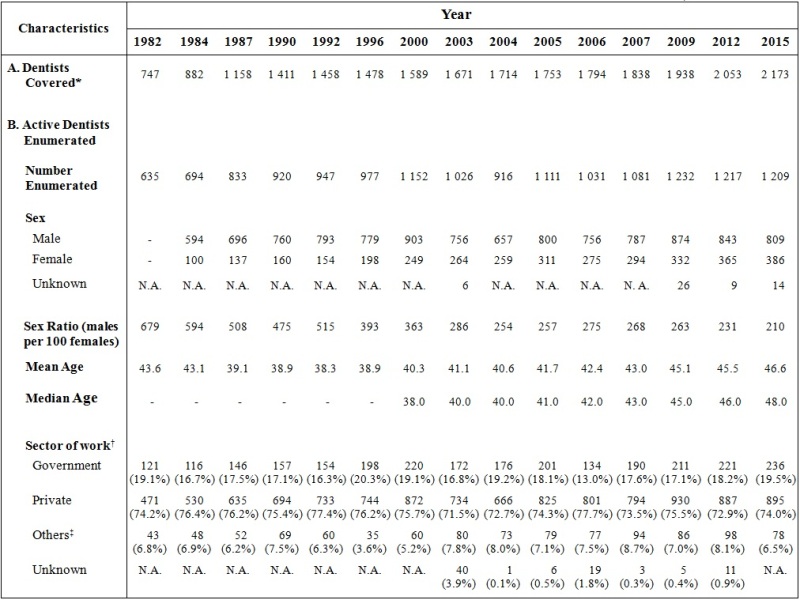2015 Health Manpower Survey
Summary of the Characteristics of Dentists Enumerated
I. Dentists Covered
1.1 The dentists covered in the 2015 Health Manpower Survey were dentists registered with the Dental Council of Hong Kong on the list 1 of registered dentists resident in Hong Kong under the Dentists Registration Ordinance (Chapter 156) as at the survey reference date - 31.8.2015.
1.2 The number of dentists covered was 2 173.
1.3 Of the 2 173 dentists covered, 1 257 responded to the survey, giving an overall response rate of 57.8%. Among the respondents, 1 218 (96.9%) were economically active 2,3 (active) in the local dental profession as at 31.8.2015 and 39 (3.1%) were economically inactive 2,4 (inactive) (Chart A) .
1.4 Of the 1 218 active dentists enumerated, 1 209 (99.3%) were practising in the local dental profession, seven (0.6%) were seeking jobs and two (0.2%) were waiting to take up a new job in the local dental profession during the 30 days before the survey. The survey results presented in paragraph 1.6 below were based on the 1 209 responding dentists who were practising in the local dental profession as at 31.8.2015. As certain questionnaires contained missing information, percentages presented below may not add up to 100%.
1.5 Of the 39 inactive dentists, 21 (53.8%) reported practising overseas / in the Mainland and 18 (46.2%) reported not seeking jobs in the local dental profession during the 30 days before the survey (Chart A) . Among the 18 inactive dentists who reported not seeking jobs, the main reasons reported for not seeking jobs included: nine (50.0%) were retired, three (16.7%) wanted to take a rest / had no motive to work / had no financial need, three (16.7%) were engaged in household duty, etc.
1.6 A total of 14 dentists did not indicate their gender. Of the remaining 1 195 active dentists enumerated who were practising in the local dental profession, 809 (67.7%) were male and 386 (32.3%) were female, giving an overall sex ratio (males per 100 females) of 210. Apart from 15 dentists who did not indicate age, the median age of the remaining 1 194 active dentists enumerated was 48.0 years. The median age of the active female dentists enumerated was 39.0 years and that of their male counterparts was 51.0 years.
1 As the 2015 Health Manpower Survey only aimed at covering all dentists practising in Hong Kong, dentists on the list of registered dentists outside Hong Kong of the Dental Register were excluded from the survey.
2 In the survey, the criteria used in defining economically active / inactive followed those recommended by the International Labour Organization, which are also being used by the Census and Statistics Department in Hong Kong.
3 "Economically active" dentists comprised all "employed" and "unemployed" dentists. "Employed" dentists referred to those dentists practising in the dental profession in Hong Kong during the survey period, while "unemployed" dentists referred to those dentists who (a) were not practising in the local dental profession during the survey period; (b) had been available for work during the seven days before the survey; and (c) had sought work in the local dental profession during the 30 days before the survey.
4 "Economically inactive" dentists comprised the dentists who were not practising in the dental profession in Hong Kong during the survey period, but excluding those who had been on leave during the survey period and those who were "economically active" but "unemployed".
Chart A : Activity Status of Dentists Covered

| Notes﹕ | * | Figure refers to the number of responding dentists who (a) were not practising in the dental profession in Hong Kong during the survey period; (b) had been available for work in the local dental profession during the seven days before the survey; and (c) had sought work in the local dental profession during the 30 days before the survey. |
| † | Figure refers to the number of responding dentists who (a) were not practising in the dental profession in Hong Kong during the survey period; (b) had not been available for work during the seven days before the survey; and (c) were waiting to take up a new job in the local dental profession during the 30 days before the survey. | |
| ‡ | Figure refers to the number of responding dentists who reported working in other professions or undertaking study. | |
| Percentages may not add up to 100% due to rounding. |
1.7 The responding active dentists enumerated were requested to indicate the characteristics of their main jobs 5 . Distribution by sector for the main job showed that the largest proportion (74.0%) of the active dentists enumerated were working in the private sector, followed by those working in the Government (19.5%), the academic sector 6 (3.1%) and the subvented sector (2.7%). Among the 895 active dentists enumerated who were working in the private sector, the largest proportion (60.0%) were working in solo practice, followed by those working in group practice (38.4%) and other private institutions (1.6%).
1.8 The median age of the active dentists enumerated was 50.0 years for those working in the private sector, followed by 47.0 years for those working in the Hospital Authority, 45.0 years for those working in the Government, 42.0 years for those working in the subvented sector and 38.0 years for those working in the academic sector.
1.9 Of the 1 209 active dentists enumerated, 83.7% spent most of their working time on general dentistry, followed by 13.9% on specialist practice, 1.4% on administration / management and 1.0% on teaching / education.
1.10 The median number of hours of work (excluding meal breaks) per week of the 1 209 active dentists enumerated was 42.0 hours. Among them, 56 (4.6%) active dentists enumerated were required to undertake on-call duty (excluding normal duty), with a median of 11.0 hours of on-call duty per week.
1.11 Regarding the average number of consultations / patients encountered per working day, 53.1% of the active dentists enumerated reported to have a range of 11 to 20, 28.5% reported to have 10 or below and 17.0% reported to have more than 20.
1.12 Of the 1 209 active dentists enumerated, 69.2% held Bachelor’s Degree issued by institutions in Hong Kong, 20.1% held Bachelor’s Degree issued by overseas institutions and 10.3% held Doctoral Degree issued by overseas institutions as their basic qualifications.
1.13 Of the 1 209 active dentists enumerated, 533 (44.1%) had obtained additional qualification(s) and 676 (55.9%) did not obtain any additional qualification. Of the 533 dentists with additional qualification(s), 258 (48.4%) had obtained one additional qualification. Among them, 84 (32.6%) had obtained Membership, 79 (30.6%) had obtained Master’s Degree, 53 (20.5%) had obtained Fellowship and 30 (11.6%) had obtained Post-graduate Diploma as their additional qualifications.
1.14 Of the 533 active dentists enumerated who had obtained additional qualification(s), 439 (82.4%) had obtained additional qualification in one field. Among them, 39.2% in general dentistry, 13.7% in prosthodontics, 10.0% in orthodontics, 8.4% in oral and maxillofacial surgery, 7.1% in periodontology, 6.6% in paediatric dentistry, and 5.9% in dental public health.
1.15 1.15 Among the 533 active dentists enumerated who had obtained additional qualification(s), some of them selected more than one field of additional qualification. The total number of count of active dentists enumerated who had obtained additional qualification was 639, in which 39.6% had obtained additional qualification in general dentistry, 15.2% in prosthodontics, 8.1% in orthodontics, 7.5% in oral and maxillofacial surgery, 6.9% in dental public health, 6.7% in periodontology and 5.5% in paediatric dentistry.
5 Main jobs referred to the jobs in which the dentists had spent most of their working time.
6 Includes universities and the Prince Philip Dental Hospital.
1.16 Regarding Continuing Medical Education (CME) / Continuing Professional Development (CPD) training, 1 013 (83.8%) of the active dentists enumerated revealed that they had participated in CME / CPD training in 2015, 191 (15.8%) did not participate in any CME / CPD training and five (0.4%) did not reveal whether they had participated in CME / CPD training or not. Among the 1 013 active dentists enumerated who had participated in CME / CPD training, the distribution of CME / CPD points attained in the past 12 months was: 1 to 5 points (16.0%), 6 to 10 points (12.9%), 11 to 15 points (14.6%), 16 to 20 points (17.0%) and more than 20 points (39.5%).
II. Trend Analysis
2.1 Comparison of findings of the 2015 HMS with those surveys conducted before 2003 should be cautious as the survey methods and reference date had been changed.
2.2 Between 1982 and 2015, the number of dentists increased from 747 to 2 173. (Chart B)
2.3 A decreasing trend was observed in the proportion of male dentists, as indicated by a continuous decrease in the overall sex ratio (males per 100 females) from 679 in 1982 to 210 in 2015 (Table A) .
Chart B : Number of Dentists Covered by Year (1982, 1984, 1987, 1990, 1992, 1996, 2000, 2003, 2004, 2005, 2006, 2007, 2009, 2012 and 2015)

| Note : | Figures of the year 2000 and before refer to the number of dentists registered with the Dental Council of Hong Kong on the list of registered dentists resident in Hong Kong as at the 1st of July of the respective years, the figure of 2003 refers to that as at the 31st of December 2003 and the figures of 2004 to 2007, 2009, 2012 and 2015 refer to that as at the 31st of August of the respective years. |
Table A : Selected Characteristics of Active Dentists Enumerated (1982, 1984, 1987, 1990, 1992, 1996, 2000, 2003, 2004, 2005, 2006, 2007, 2009, 2012 and 2015)

| Notes﹕ | * | Figures of 2000 and before refer to the number of dentists registered with the Dental Council of Hong Kong on the list of the registered dentists resident in Hong Kong as at the 1st of July of the respective years, the figures of 2003 refer to that as at the 31st of December 2003, whereas the figures of 2004 to 2007, 2009, 2012 and 2015 refer to that as at the 31st of August of the respective years. |
| † | In 2003 to 2007, 2009, 2012 and 2015, the sector refers to the sector of main job. | |
| ‡ | Figures include Hospital Authority, subvented sector, academic sector and the Prince Philip Dental Hospital. | |
| There may be slight discrepancy between the sum of individual items and the total due to rounding. | ||
| N.A. Not applicable | ||
| ‘-’ Not available |